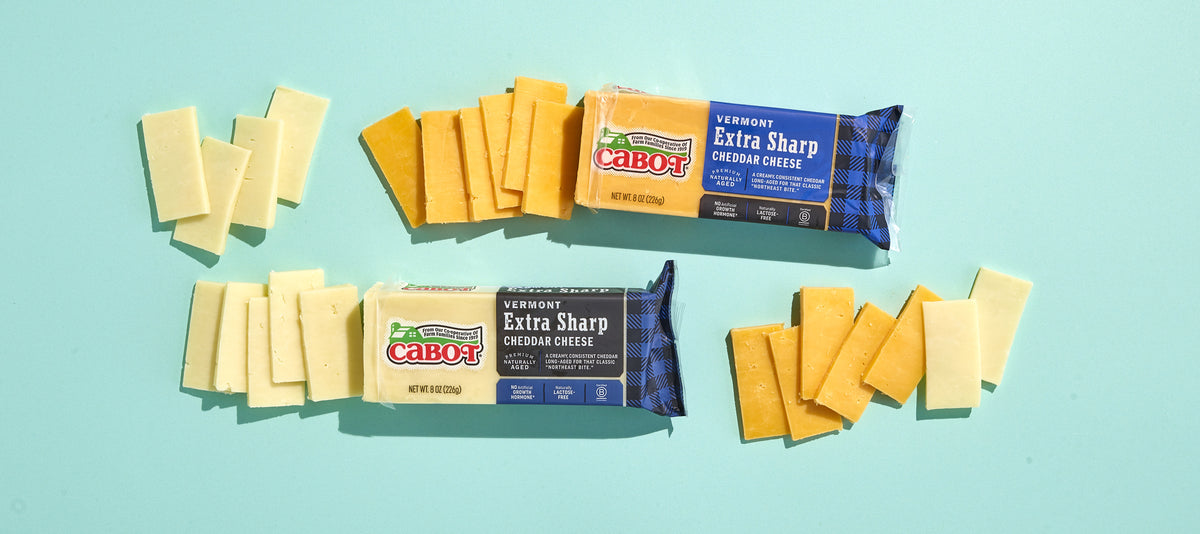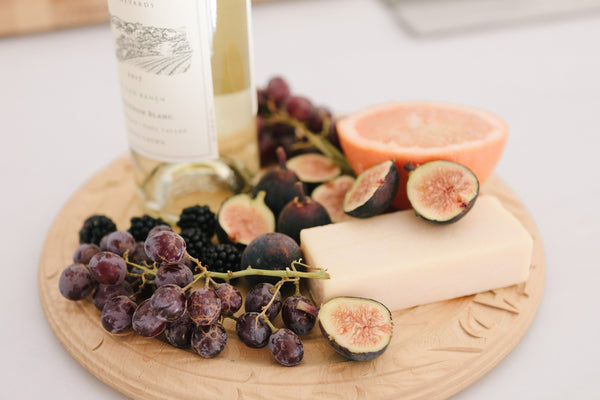
The Cheddar Encyclopedia: Facts about Cheddar Cheese
Cheddar cheese is one of the most popular and beloved types of cheese in the world. It has been around for over 800 years and has evolved into many different varieties and flavors. At Cabot Creamery, we take pride in making some of the best cheddar cheese in the world - after all, Vermont is home to the world’s best cheddar! Keep reading for everything you need to know about cheddar cheese, from its history and production process to its distinct types and uses in cooking. Whether you're a cheddar cheese aficionado or simply curious to learn more, we've got you covered!
History of Cheddar Cheese
The history of cheddar cheese dates to the 12th Century, in the English village of Cheddar in Somerset. According to the story, a milkmaid brought a bucket of milk to a cave to keep it cool and forgot about it. When she returned a few days later, it had hardened…and she decided to eat it.
Originally made by local farmers, cheddar cheese became popular due to its long shelf life and portability, making it an ideal food for travelers and soldiers. Very soon after, cheddar became a hit among England’s wealthy elite, and over time, the production of cheddar cheese spread throughout England and eventually to other parts of the world. Today, cheddar cheese is one of the most widely produced and consumed cheeses, with variations in flavor, texture, and appearance found in different regions around the globe.
Types of Cheddar
There are many diverse types of cheddar cheese available, each with its own unique flavor and texture. Mild cheddar is young and smooth, with a subtle, buttery taste. Medium cheddar has a slightly stronger flavor, while sharp cheddar has a tangy and robust taste that pairs well with bold flavors. Aged cheddar can range from one year to over a decade in age, with a crumbly texture and sharp flavor that intensifies with age. Other varieties of cheddar cheese include smoked cheddar, which has a distinct smoky flavor, and flavored cheddar, which is infused with herbs, spices, or other ingredients. White cheddar is made from the same process as traditional cheddar cheese but is not colored with annatto, giving it a pale color.
White vs. Yellow Cheddar Cheese
Coloring was originally added to distinguish where the cheddar cheese was made (yellow cheeses derive their color from an additive). Cheddar cheeses made in the New England states—including Cabot Cheddar cheese made in Vermont—traditionally do not contain color additives, (our yellow cheeses use a natural, plant-based coloring called Annatto), and retain their natural white color.
💡Annatto: the flavorless fruit from achiote trees found in South America that holds no significant taste or aroma, and has been used in cheeses for generations.

Cheddar Cheese Sharpness
Aging is the only difference between mild and sharper cheddar. The longer cheese is aged naturally, the sharper and more pronounced the cheddar flavor becomes.
Mild Cheddar cheese is generally aged for 2 to 3 months, whereas an extra sharp might be aged for as long as a year. Our sharpest cheddar cheeses, such as Cabot Private Stock and Cabot Vintage Choice, are aged between 16 months and two or more years!
View more on our Cheddar Sharpness Scale.

Why Are Some Cheeses Waxed?
Cheddar cheese is packaged airtight to eliminate molding.
Although wax packaging is the most traditional, modern methods utilize plastic films and vacuum packing or a “gas flushing” technique to remove air before sealing. Regardless, the surface mold that sometimes forms on cheese is completely harmless; simply trim it off, reseal in fresh plastic wrap and store in the refrigerator.

💡CHEESE SWEATING? It’s common for some moisture to develop inside the package of naturally produced Cheddar cheese because of “syneresis,” a process in which proteins release moisture. This is a naturally occurring process and has no impact on the quality of our cheese. In fact, the process allows cheddar cheese to reach the next stage—the sharp crumbly texture we love! Simply wipe off excess moisture, wrap the cheese in fresh parchment or wax paper and store in the refrigerator.
Get useful tips and resources now.

Kosher & Halal Diets
Cabot is certified kosher and offers kosher products. We maintain kosher standards under the supervision of a rabbi and offer a broad range of halal cheddar cheeses that meet the rules and regulations specified by a supervising Islamic Administrator.
💡A cheese can be a Kosher cheese if it meets the dietary requirements of the Jewish religion's laws, known as kashrut.
💡 Halal cheese is a cheese that has been created using ingredients that are in accordance with the Islamic laws pertaining to food.

Is Cheddar Lactose Free?
Cabot produces many lactose-free cheeses. Some of our cheeses that contain zero (0) grams of lactose include Cheddar, Light Cheddar, Monterey Jack, Pepper Jack and Muenster.
The removal of lactose occurs naturally during the cheese making process. Please look for the 0 Grams of Lactose Per Serving Icon on the packaging of your favorite Cabot cheese products to be sure they are naturally lactose-free cheese.
Learn more about Lactose-Free Cheese.

Cooking with Cheddar
When it comes to cooking with cheddar cheese, different forms of cheese are used for different purposes. Thin slices of cheddar cheese are ideal for providing an even coating and ensuring that all parts of a dish are covered. This makes cheddar cheese a popular choice for dishes such as sandwiches, burgers, and quesadillas. Additionally, when used as a topping for baked dishes, the cheese turns crispy and golden in the oven, while a soft and stringy consistency develops when exposed to heat.
Grated cheddar cheese is best for quick and easy melting, making it a perfect ingredient for dishes such as macaroni and cheese, nachos, and soups. Grating the cheese also provides a more consistent and uniform texture, which makes it ideal for achieving a satisfyingly crunchy texture. For example, grated cheddar cheese can be sprinkled over casseroles, salads, and baked potatoes to add a flavorful crunch. Overall, whether you use thin slices or grated cheddar cheese, this versatile cheese can add a delicious and satisfying flavor to a wide range of dishes.
Melting Cheddar Cheese
Mild cheddar will melt easily and consistently; however, low-fat cheddar cheese and sharper cheddar melt better if first shredded or cut into strips and cooked over low heat.

Learn all about how to best melt cheese with our How to Melt Cheese guide!
What Pairs with Cheddar Cheese?
Wine - Pairing wine and cheese is a matter of personal taste, although the flavors of both should complement each other. Intense flavored cheeses such as Extra Sharp Cheddar, blue cheese and Gouda match well with a bold Pinot Noir or Cabernet. Mild cheeses or a goat cheese pair great with a round, mellow Merlot. A fresh and fruity Chardonnay is a match for milder cheese varieties, enhancing the creaminess of a Mild Cheddar or Colby Jack cheese, with just the right whisper of sweet.
Get Wine & Cheese Pairing Tips.
💡SERVING TIP: Like a fine red wine, cheddar cheese is always best served at room temperature. Allowing the cheese to sit for 30 minutes before serving brings out the full flavor and best consistency.

Beer - Cheese and beer lovers share a common passion. They both appreciate award-winning taste! The right beer and cheddar cheese melded together can be a magical taste explosion.
For instance, the pleasant bitterness of English Pale Ale—the British idea of perfect balance of malt and hops—is a beautiful complement to Extra Sharp Cheddar roasted potatoes. Roast wedges of potatoes with olive oil, rosemary and coarse salt; top with shredded cheddar and serve with grape tomatoes.
Get Beer & Cheese Pairing Tips Now.

Award Winning Cheddar
Cabot cheddar cheese varieties have been awarded Best in Class at national and international cheese competitions for more than twenty years running! So, it probably goes without saying that we’re passionate about cheese. In fact, most of us can distinguish between mild and sharp cheddar cheese with just one bite!
We also know how cheddar cheese is made, how it’s best served, and most importantly, how to distinguish its sharpness. But for the farm families who own Cabot, it’s not just about great tasting cheese—making the World’s Best Cheddar, and other fine American cheeses, is our livelihood. So, we also analyze cheese industry market trends and statistics—particularly as they pertain to small cheese making companies and naturally aged cheeses. Simply put, we’re cheese experts.
As a farmer-owned co-operative, Cabot works in partnership with the Vermont Dairy Industry, the Vermont Cheese Council, and state agencies including Agriculture and Tourism. We also work closely with our friends and neighbors in related industries. If you have a question we can’t answer, chances are we know someone who can!













